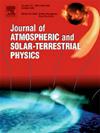Sunspot numbers, cosmic rays, and ozone variability: Correlation and wavelet analysis for mid-latitudes
IF 1.8
4区 地球科学
Q3 GEOCHEMISTRY & GEOPHYSICS
Journal of Atmospheric and Solar-Terrestrial Physics
Pub Date : 2025-01-25
DOI:10.1016/j.jastp.2025.106445
引用次数: 0
Abstract
This study investigates the intricate relationships between Total Ozone Content (TOC) and solar activity indicators, including Sunspot Number (SSN) and Cosmic Ray (CR) flux, across 11 Middle Eastern stations (18.22°N–39.94°N) over the period 1979–2022. Employing correlation and wavelet analyses, the research provides robust evidence of significant associations between TOC and solar phenomena, with positive correlations observed for TOC-SSN (R = 0.37to R = 0.50) and negative correlations for TOC-CR (R = −0.37 to R = −0.44). Seasonal variations were pronounced, with the strongest correlations during summer.
Wavelet analysis identified dominant periodicities, including an annual cycle (1-year) reflecting seasonal ozone variations, sub-annual periodicities (3–6 months) with geographic dependence, and inter-annual periodicities (2–4 years) linked to the Quasi-Biennial Oscillation (QBO) and El Niño-Southern Oscillation (ENSO). Coherence wavelet spectra demonstrated robust annual coherence across all stations, solar cycle coherence (4–8 years) in northern and central stations, and intermittent short-term periodicities (0.25–0.5 years). Coherence patterns exhibited latitudinal dependence, with stronger solar cycle coherence in northern stations and more variable patterns in southern stations, and were temporally modulated by solar activity phases, being stronger during solar maxima.
These findings underscore the critical influence of solar phenomena on ozone variability, advancing our understanding of atmospheric dynamics and their implications for climate and environmental systems.
太阳黑子数、宇宙射线和臭氧变率:中纬度地区的相关性和小波分析
本文研究了1979-2022年11个中东站(18.22°N - 39.94°N)的总臭氧含量(TOC)与太阳活动指标(包括太阳黑子数(SSN)和宇宙射线(CR)通量)之间的复杂关系。利用相关分析和小波分析,该研究提供了TOC与太阳现象之间显著相关的有力证据,TOC- ssn与TOC- ssn呈正相关(R = 0.37 ~ R = 0.50), TOC- cr与TOC- cr呈负相关(R = - 0.37 ~ R = - 0.44)。季节变化明显,夏季相关性最强。小波分析确定了主要的周期,包括反映季节性臭氧变化的年周期(1年)、具有地理依赖性的次年周期(3-6个月)和与准两年振荡(QBO)和El Niño-Southern振荡(ENSO)相关的年际周期(2-4年)。相干小波谱在所有台站表现出较强的年相干性,在北站和中心站表现出4 ~ 8年的太阳周期相干性,以及0.25 ~ 0.5年的间歇性短期周期性。相干型表现出纬度相关性,北站太阳周期相干性强,南站变化型多,且受太阳活动相位的时间调制,在太阳活动极大期更强。这些发现强调了太阳现象对臭氧变率的重要影响,促进了我们对大气动力学及其对气候和环境系统的影响的理解。
本文章由计算机程序翻译,如有差异,请以英文原文为准。
求助全文
约1分钟内获得全文
求助全文
来源期刊

Journal of Atmospheric and Solar-Terrestrial Physics
地学-地球化学与地球物理
CiteScore
4.10
自引率
5.30%
发文量
95
审稿时长
6 months
期刊介绍:
The Journal of Atmospheric and Solar-Terrestrial Physics (JASTP) is an international journal concerned with the inter-disciplinary science of the Earth''s atmospheric and space environment, especially the highly varied and highly variable physical phenomena that occur in this natural laboratory and the processes that couple them.
The journal covers the physical processes operating in the troposphere, stratosphere, mesosphere, thermosphere, ionosphere, magnetosphere, the Sun, interplanetary medium, and heliosphere. Phenomena occurring in other "spheres", solar influences on climate, and supporting laboratory measurements are also considered. The journal deals especially with the coupling between the different regions.
Solar flares, coronal mass ejections, and other energetic events on the Sun create interesting and important perturbations in the near-Earth space environment. The physics of such "space weather" is central to the Journal of Atmospheric and Solar-Terrestrial Physics and the journal welcomes papers that lead in the direction of a predictive understanding of the coupled system. Regarding the upper atmosphere, the subjects of aeronomy, geomagnetism and geoelectricity, auroral phenomena, radio wave propagation, and plasma instabilities, are examples within the broad field of solar-terrestrial physics which emphasise the energy exchange between the solar wind, the magnetospheric and ionospheric plasmas, and the neutral gas. In the lower atmosphere, topics covered range from mesoscale to global scale dynamics, to atmospheric electricity, lightning and its effects, and to anthropogenic changes.
 求助内容:
求助内容: 应助结果提醒方式:
应助结果提醒方式:


